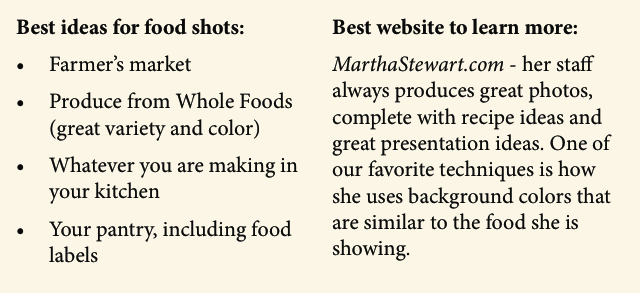Food Photo Tips
 We often get compliments on the food photos that appear in the blog on foodandhealth.com. In fact, one of the most popular posts is the one that is called Salad Presentations.Here are a few tips to get better shots of food for your website, PowerPoint presentation or newsletter.1) Get enough light. If you are using a point and shoot camera or smart phone, try to use daylight fluorescent bulbs or natural daylight. A flash from the camera will often be too harsh. If you must use flash, step back and zoom in so you are not too close with the flash. Take care that you do not have excess shadows or that you are not in front of your camera causing a large shadow!2) If you are using a DSLR camera you can use a tripod and reflectors to help make the most of the light you have. An f stop of 5 to 8 is best and you can choose aperture priority. This means the camera will select the shutter speed. The tripod will ensure a clear shot. If you don’t have a shutter release cable, use the self timer on the camera. If you are pressing the shutter release you can cause motion and a blurry photo.3) Use white plates on colored backgrounds. Food almost always looks better on white plates.4) Use smaller plates. Items look better when photographed in smaller portions on small plates rather than trying to make a huge plate full of food.5) Fill the frame with the food. The focus should be the food.6) Make sure plates and utensils are very clean.7) Collect interesting plates, utensils, napkins and place- mats and keep these stored together so you can shoot quickly.8) Consider the colors of what you are shooting. If you have a lot of brown items you might want to garnish with brighter colored items or use brightly colored napkins nearby for better appeal.9) Don’t be afraid to decorate a place setting for a nicely finished photo that has visual interest.
We often get compliments on the food photos that appear in the blog on foodandhealth.com. In fact, one of the most popular posts is the one that is called Salad Presentations.Here are a few tips to get better shots of food for your website, PowerPoint presentation or newsletter.1) Get enough light. If you are using a point and shoot camera or smart phone, try to use daylight fluorescent bulbs or natural daylight. A flash from the camera will often be too harsh. If you must use flash, step back and zoom in so you are not too close with the flash. Take care that you do not have excess shadows or that you are not in front of your camera causing a large shadow!2) If you are using a DSLR camera you can use a tripod and reflectors to help make the most of the light you have. An f stop of 5 to 8 is best and you can choose aperture priority. This means the camera will select the shutter speed. The tripod will ensure a clear shot. If you don’t have a shutter release cable, use the self timer on the camera. If you are pressing the shutter release you can cause motion and a blurry photo.3) Use white plates on colored backgrounds. Food almost always looks better on white plates.4) Use smaller plates. Items look better when photographed in smaller portions on small plates rather than trying to make a huge plate full of food.5) Fill the frame with the food. The focus should be the food.6) Make sure plates and utensils are very clean.7) Collect interesting plates, utensils, napkins and place- mats and keep these stored together so you can shoot quickly.8) Consider the colors of what you are shooting. If you have a lot of brown items you might want to garnish with brighter colored items or use brightly colored napkins nearby for better appeal.9) Don’t be afraid to decorate a place setting for a nicely finished photo that has visual interest.
